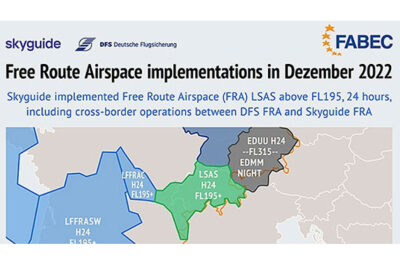The initiative is part of a comprehensive package of measures that to date includes over 750 improvements and facilitations for airspace users.
Functional Airspace Block Europe Central (FABEC) ANSPs have lifted over 500 route restrictions since the start of the pandemic in March, avoiding the need for aircraft to operate at inefficient flight levels or fly longer routes. Most of these route restrictions were put in place in times of high traffic demand to stabilize the network and ensure safety while providing additional capacity. Airspace users are now in a position to plan optimized flight profiles due to the lifting of route restrictions compiled by the Network Manager in the so-called Route Availability Documents (RAD) Appendix 3. Shortened routes and optimized vertical flight profiles are both strong contributors to lowering fuel consumption and reducing the environmental footprint of aviation. The initiative is part of a comprehensive package of measures that to date includes over 750 improvements and facilitations for airspace users. On top of this, FABEC ANSPs will remove further RAD restrictions in 2020 as part of a continuous programme to optimise flight profiles and streamline traffic flow.
“FABEC ANSPs are taking advantage of the traffic downturn caused by COVID-19 to lift unnecessary constraints in times of low traffic and optimise routes in some of Europe’s most complex airspace,” says Peggy Devestel, Chair FABEC Standing Committee Operations. “RAD measures bring safety, predictability and stability to airspace operations. Hence, they play an important role in the efficiency of the overall European network.”
Answering the high and unexpected traffic demand from 2017 to 2019 several RAD restrictions were introduced by FABEC ANSPs in close cooperation with the Network Manager. Similar to road traffic signals, these measures directed airspace users around the most congested areas. As a result, airspace users experienced a more stable network and less delay, and while these flights generated higher emissions, the environmental impact was still lower than it would have been had they not been introduced.
Tatiana is the news coordinator for TravelDailyNews Media Network (traveldailynews.gr, traveldailynews.com and traveldailynews.asia). Her role includes monitoring the hundreds of news sources of TravelDailyNews Media Network and skimming the most important according to our strategy.
She holds a Bachelor's degree in Communication & Mass Media from Panteion University of Political & Social Studies of Athens and she has been editor and editor-in-chief in various economic magazines and newspapers.










































































































































































